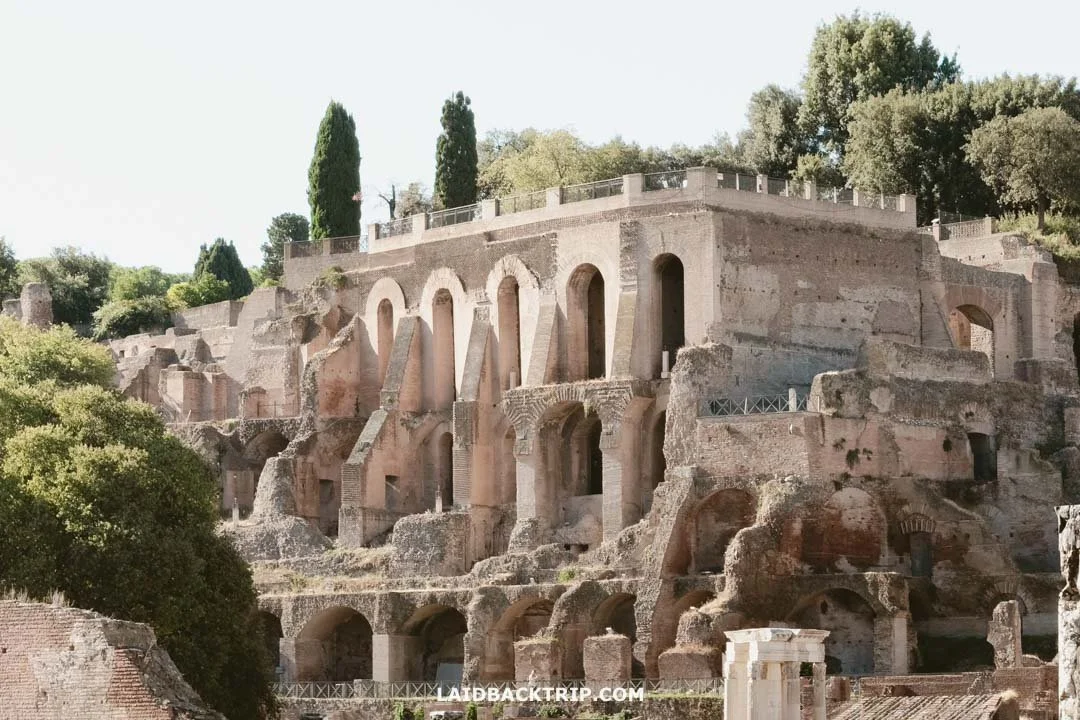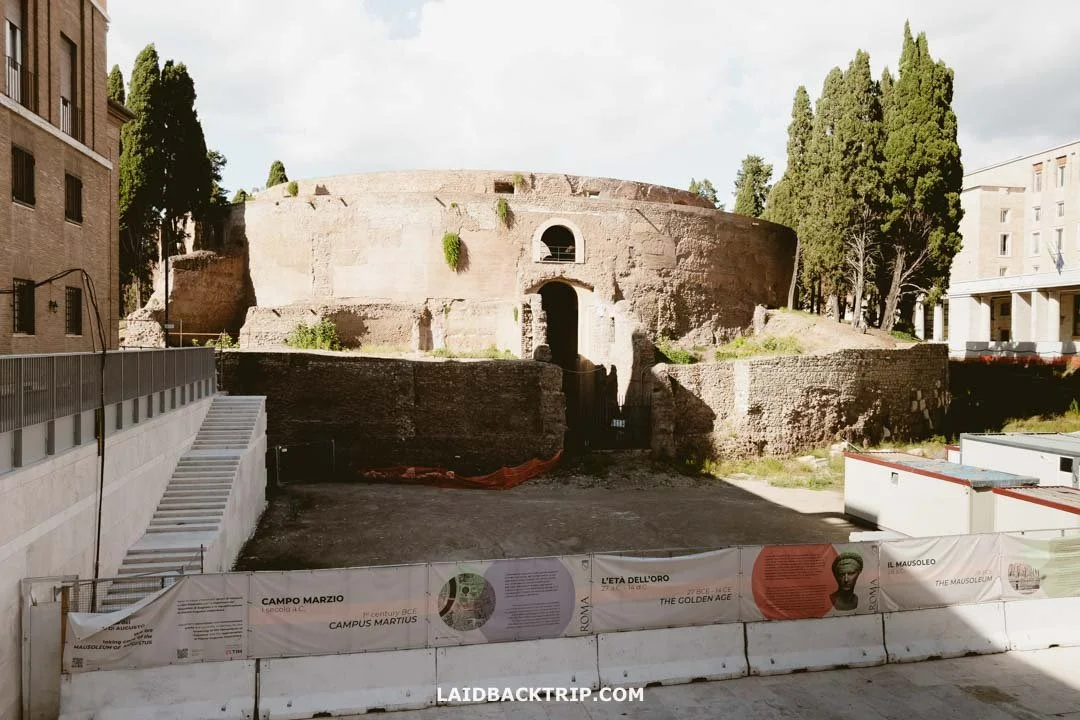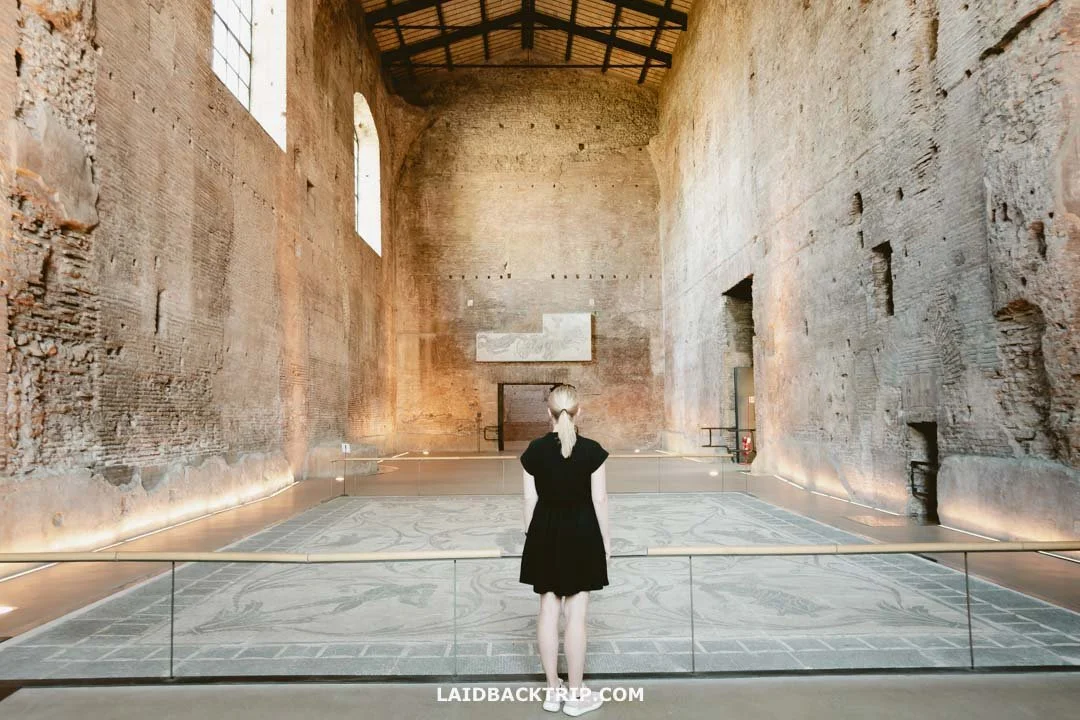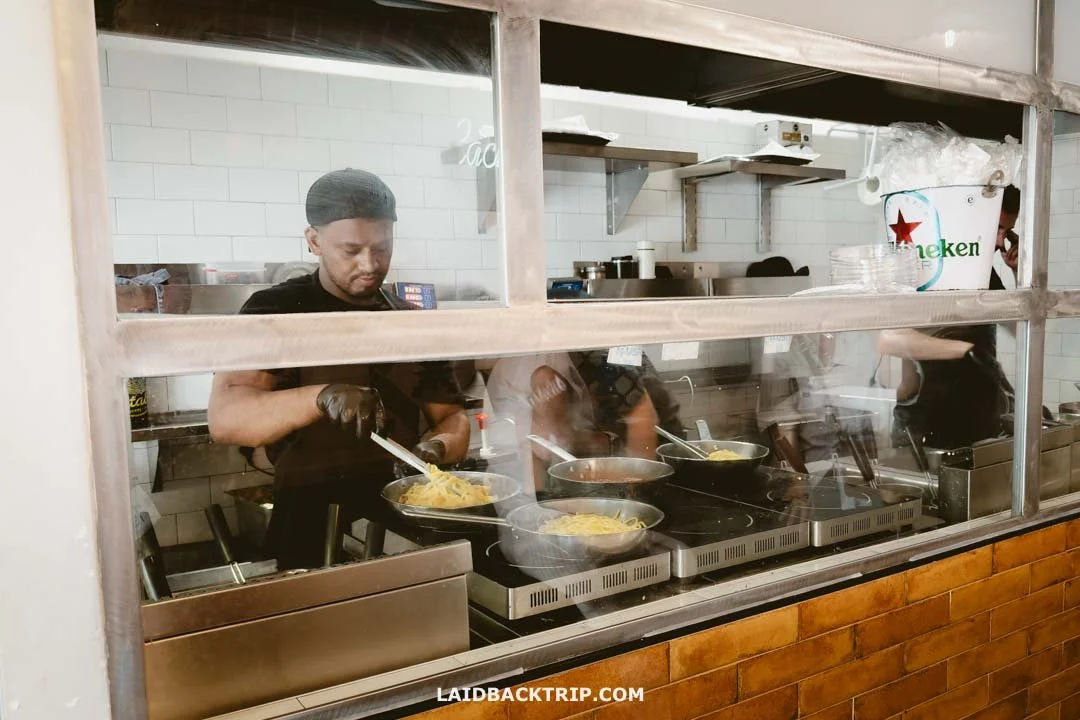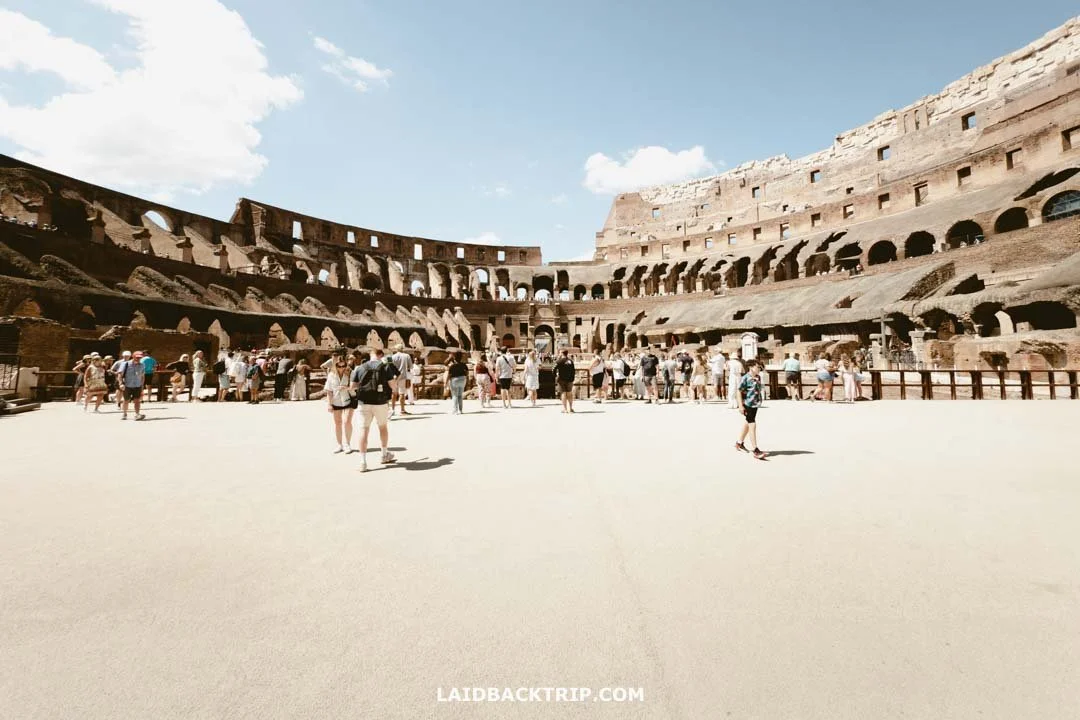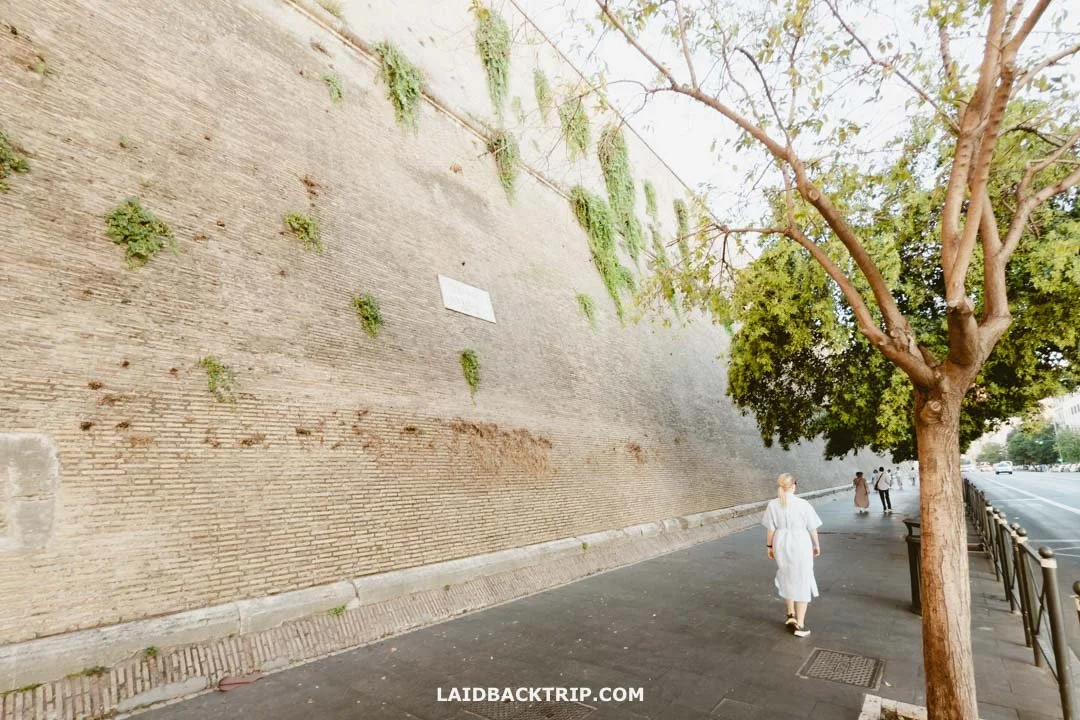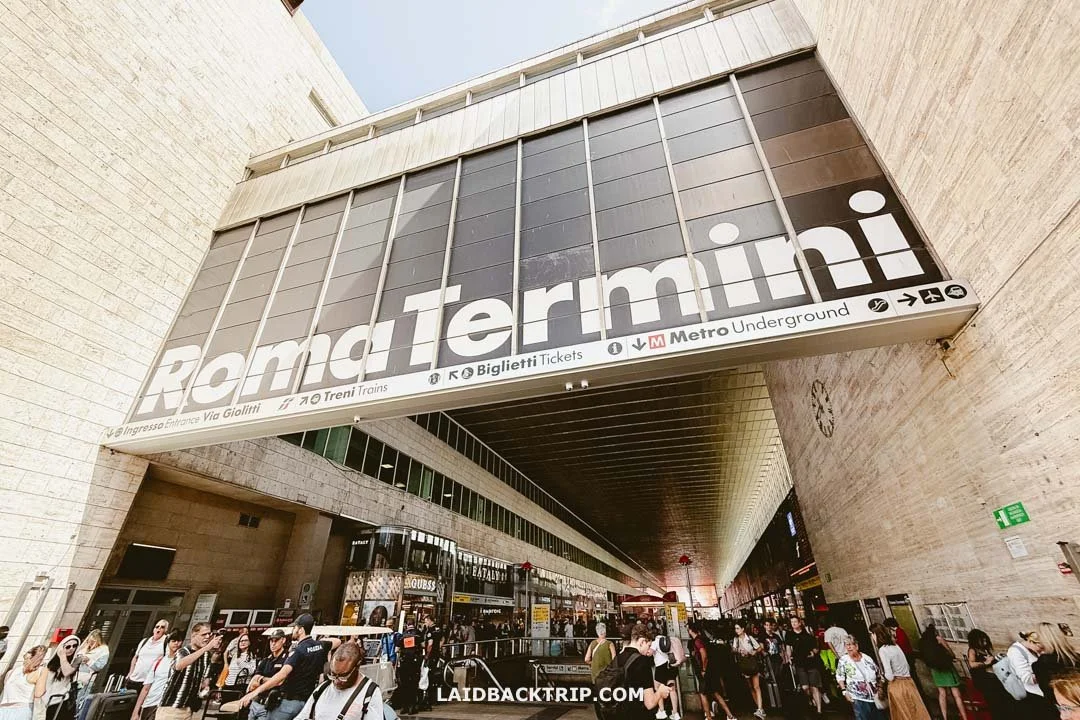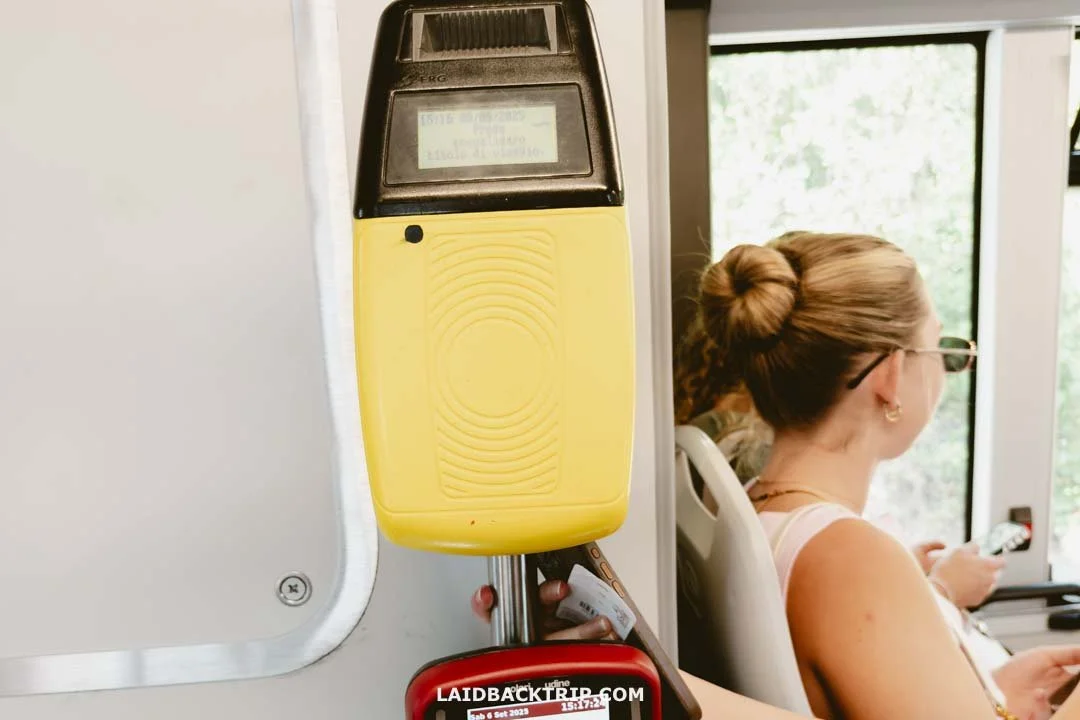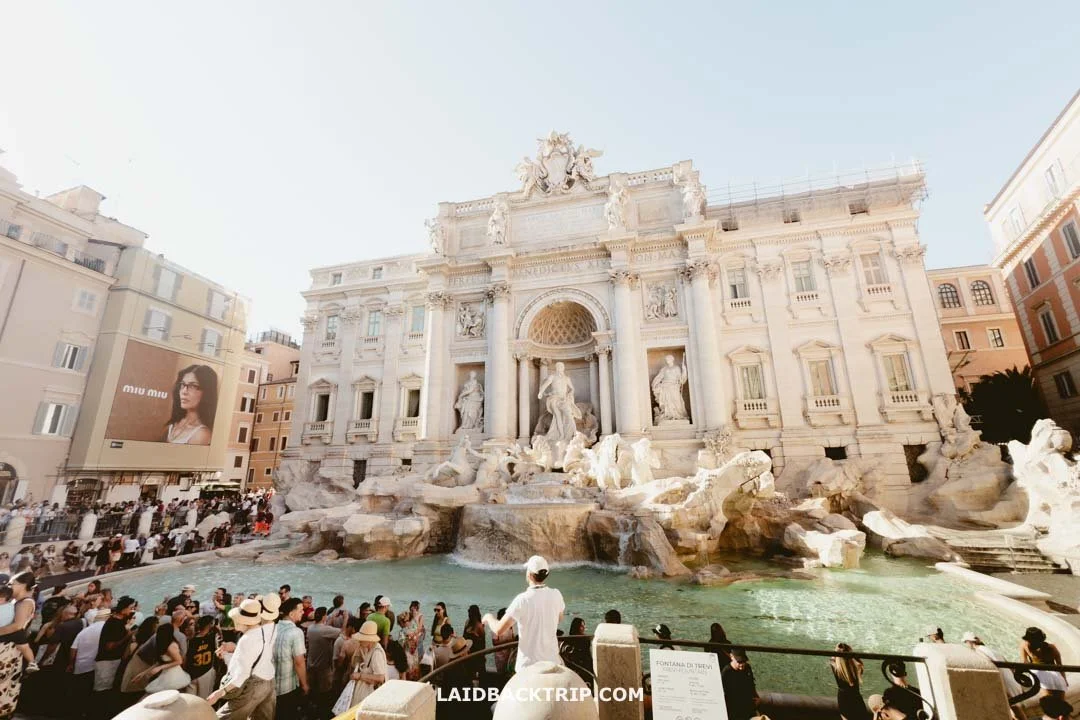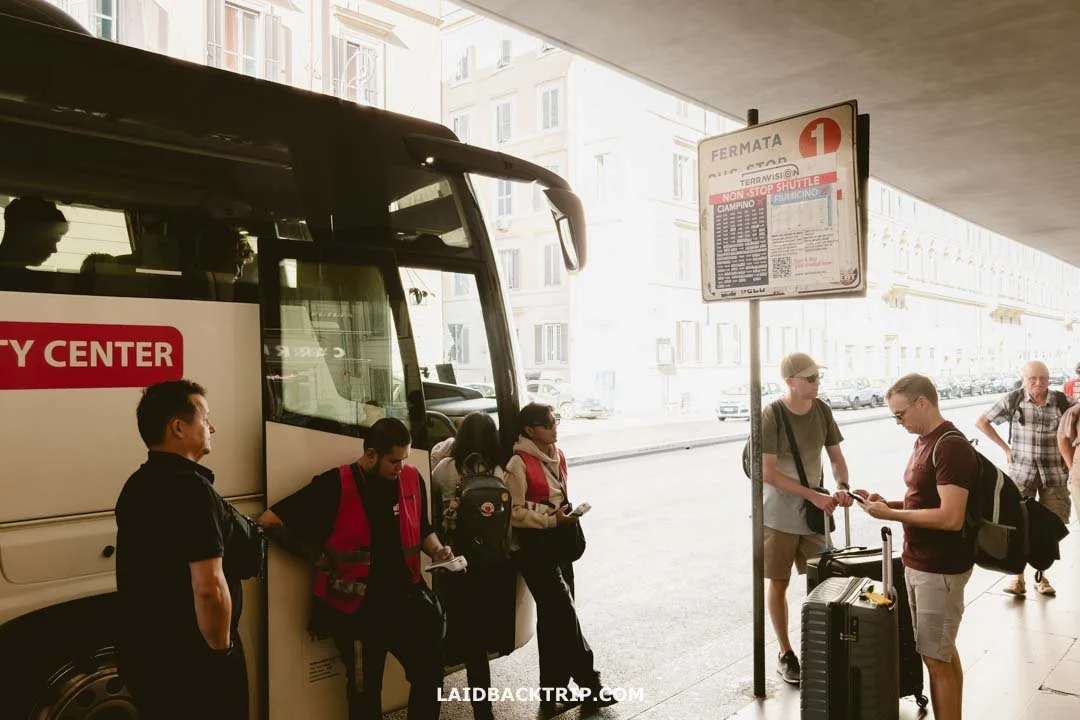Visiting Rome for the First Time
Rome was easily one of the most extraordinary cities we've ever had the chance to visit.
This was Martin's and my first visit to Rome. Here are all the travel tips and essentials we gathered there!
Choosing Rome as our next destination was quite a process, especially since we originally planned a completely different kind of trip and destination(s). But because of the weather, we had to switch things up. Once we finally settled on Rome, booking the flights, accommodation, and tickets to the top attractions took just a few quick clicks.
And right after we made the decision, we both got super excited about going. But who wouldn't, right? Rome is one of the most amazing places in the world, filled with iconic places like the Colosseum and St. Peter's Basilica.
I'd always wanted to see Rome, but for a while, it felt like we might never get there. Even though it's Rome, we somehow kept finding reasons to postpone the trip, keeping it in our "travel drawer" for later. But as the saying goes, all roads lead to Rome, and it was only a matter of time before we answered the call of the Eternal City and finally made it there.
For Martin, this was actually his second trip to Rome, but needless to say, he hadn't explored much the first time since it was a short visit more than two decades ago. His memory of many things was pretty fuzzy, and when we talked about it, he remembered surprisingly little. And since so much has changed since then, it felt like a totally new experience for him, too.
But this time, we weren't in a rush and really wanted to focus just on Rome. Unsurprisingly, having enough time was a big reason we enjoyed this trip so much. In the end, we decided to spend eight nights in the city, which was even longer than we had first planned. During that time, we soaked up everything Rome had to offer like a sponge. So here's everything we learned on our first trip to Rome!
Rome Is History
Since I've always been into history, I was thrilled about going to Rome the second we booked our flights. But no matter how fascinating and engaging the past can be, it can also feel overwhelming and, at times, even tedious. The best thing about Roman history, though, was that it never got boring for a single moment.
We were a little worried at first, but there was really nothing to stress about. We'd already had a few similar experiences before. When we were in Mexico, we saw Mayan ruins and cenotes almost everywhere, and while they were all incredible, those days started to feel a bit repetitive. Rome, similarly, was filled with historic sites, often ruins, and ancient history was definitely its strongest card. But Roman history turned out to be far more complex and super interesting.
The frescoes in the palace of Rome's first emperor, Augustus, were over 2,000 years old!
Whether it was the legends of Rome's founding and tales of its early kings, the first steps of the Republic, the unstoppable force the Empire became under its famous emperors, or its eventual collapse, every era had its story. From the rise of papal power and struggles in medieval times to the unification of Italy in the 19th century and Rome under fascism in the 20th, history seemed to breathe from every corner.
The history was absolutely fascinating, just like the landmarks surrounding us. Whether we stood before the massive Monument to Victor Emmanuel II, the grand Piazza del Popolo, or the simple Romulus huts on the Palatine Hill, we were in awe every time. And we honestly never got the chance to feel bored. Not even for a second.
We Brushed Up on Roman History First
Before our trip, we found ourselves thinking back to all those high school history lessons about ancient Rome. Let's just say there was a lot of material we had to memorize back then. But honestly, the names, dates, and events came back much slower than we expected, and, truthfully, a lot of it had just vanished. So instead of relying only on memory, we took a more proactive approach and brushed up on at least the basics we had forgotten.
Knowing the basics of Roman history really helped at spots like the Roman Forum.
Right before the trip, we watched HBO's Rome TV show. While, of course, the drama parts were fictional, the main people and big historical events were actually portrayed quite accurately. More than anything, it was a really fun way to revive some of that long-forgotten knowledge. The show only covers a small part of Roman history, but it focuses on one of the most important and turbulent periods, the transition from Republic to Empire.
We also went down a bit of a Wikipedia rabbit hole for everything else. After all, there were about seven hundred years before those events and another five hundred after. But as expected, that way wasn't quite as fun, so we stuck to the basics. Plus, we were also eager to learn more during the trip itself.
Roman history was so engaging that once we got back home, we started listening to a Rome History podcast, which turned out to be another amazing source of information. Whatever method you choose, having a basic understanding of Rome's history really helps make sense of everything.
Every Visit Brings New Historic Sites and Experiences
One of the most fascinating things we learned about Rome is that so much of its history is still buried beneath layers that go back almost 2,800 years. The coolest part, though, is that every year, something new gets uncovered in the city. Well, maybe not every single year, as these things take time, but you get the idea.
Take the Imperial Forum, for instance. When Martin visited years ago, there wasn't a wooden walkway, which meant that while he could look at the ruins, he couldn't explore them up close since the area hadn't opened to the public yet.
Another example is the House of Augustus, which opened to visitors in 2008. The home of Rome's first emperor was one of the highlights of our trip. When it first opened, only a few people could enter each day, but now the capacity is much larger, so we were able to go inside even without a reservation.
Walking through the Domus Tiberiana after the restoration was absolutely incredible.
Speaking of the Roman Forum, there was another new addition, the Domus Tiberiana, which served as the support structure for Tiberius' Palace. This massive place opened in 2023 and now includes two Super Sites (a museum and a Christian church) as well as the unique Domitian's Ramp.
The Mausoleum of Augustus is another good example. When we were there, it still wasn't fully open to visitors, though a new museum had just opened next to it. The Stadium of Domitian museum, on the other hand, has been open since 2014. And the Domus Aurea had been closed off and on for safety issues, but luckily, it was open during our visit, though only accessible with a guided tour.
Our takeaway is that Rome's landmarks are constantly evolving. Some things stay familiar, but a lot has changed dramatically over the years. So for someone like Martin, returning after twenty years, it really was worth seeing all those places again.
When we were there, the Mausoleum of Augustus was still closed for restoration.
Some Popular Attractions Are Not Free Anymore
Probably the best example I can think of is that Martin, even though he didn't remember much from his first visit to the Roman Forum, was surprised to find there was now an admission fee. He was convinced it had been free before and said they just walked into the archaeological site back then. And he was right. The same thing happened with the Pantheon.
The Pantheon used to be free, but now there's an entrance fee.
The growing number of visitors coming to Rome every year has changed the tourist experience quite a lot. Sometimes for the better, sometimes for the worse. A downside is that you can't simply walk into the Roman Forum anymore like folks once could. The upside is that the experience has gotten way better, with more to explore than ever before (at lest in the Roman Forum).
Considering how many more tourists come to Rome now than twenty years ago, it's easy to see why entry fees were introduced. This also brings us to another related topic: lines and ticket reservations.
Our Tip: Every first Sunday of the month, all state-operated museums and archaeological sites in Italy, like the Colosseum, Roman Forum, and Palatine Hill, are open to everyone for free.
Reserving Tickets in Advance
After visiting Paris, where practically everything had to be booked ahead and the lines for walk-ins were huge, Rome felt far less stressful. We were honestly relieved because this was another last-minute trip for us, and we only planned about three or four days before leaving.
There were three places we booked tickets for in advance. The first was the Colosseum, Rome's most famous attraction. We quickly realized that two of the three special areas we wanted to visit (the Attic and Underground) were fully booked for the next week, so we had to "settle" for seeing the Arena instead. Next was the Roman Forum, but in this case, we got the combo ticket with the Colosseum since it just made the most sense for us.
Since regular tickets were sold out, we had to go to the Vatican Museums on a tour.
Finally came the Vatican Museums and St. Peter's Basilica, where we had to book a guided tour to access the Sistine Chapel. The regular tickets were already gone, so we purchased the pricier guided option. It turned out to be a great choice since we usually explore on our own, and this time we could simply focus on everything around us.
For most other places, though, we didn't really stress about booking. For Castel Sant'Angelo, we simply showed up a few minutes before opening time and got in within minutes. Interestingly, by the time we left, there wasn't any line at all.
The only place that seemed completely booked up was the Borghese Gallery. It looked like we had missed our chance, but with a bit of persistence, we eventually got in. We definitely recommend checking out our detailed Borghese Gallery guide to see how we managed to secure those tickets.
That said, our biggest ticket issue was that some places allowed entry only with a guided tour, and those tours were already full since we hadn't booked early enough. This was the case for the Domus Aurea, the Catacombs of Saint Sebastian, and the Quirinal Palace.
As we were really planning this trip at the last minute, the tours through the official channels were already sold out. We also checked sites like GetYourGuide, but even there, the Domus Aurea guided tours (and pretty much all the others) were fully booked.
Rome's Waiting Lines and Times
Like most people visiting Rome, we were curious about the waiting times for major attractions such as the Colosseum and the Vatican Museums. We'd heard stories about long lines and "skip-the-line" tickets, both of which can make sightseeing far less enjoyable in the first case and pretty confusing (and even expensive) in the second.
Honestly, this turned out to be one of the nicest surprises of the trip. Even major attractions like the Colosseum, Roman Forum, and St. Peter's Basilica had almost no lines when we went, thanks to our timed-entry tickets booked through official websites. All the other "less famous" spots, like the Capitoline Museums or Trajan's Market, had no lines at all.
During our eight days in Rome, we visited countless sites, and the only ones where we had to wait a bit were the Vatican Museums, Castel Sant'Angelo, the Pantheon, the Trevi Fountain, and the Borghese Gallery. Even then, the wait was never more than five to ten minutes, so it really wasn't a big deal.
This was the line at Castel Sant'Angelo when we got there without a ticket.
At the Vatican Museums, the short wait happened only because we arrived a few minutes before opening and had to wait for our tour's scheduled time. The wait at the Borghese Gallery was about ten minutes too, which was the only way to enter without a pre-booked ticket. But honestly, we would've waited longer since it was such an incredible place.
At Castel Sant'Angelo, we only waited a few minutes since we arrived shortly before opening without tickets. As for the Pantheon and the Trevi Fountain, the lines moved quickly, and we were inside within ten minutes.
Explore Beyond Colosseum
One of the nicest surprises Rome gave us was that after visiting the big attractions like the Colosseum, Pantheon, and Vatican Museums, which were packed, we found surprisingly few tourists in other museums. For instance, there were some people at the Baths of Caracalla and the Capitoline Museums, but still much fewer than we'd imagined. It was great since we could take our time and truly enjoy what we were seeing.
The Baths of Caracalla were very quiet when we were there.
We also visited the "smaller" museums, like Palazzo Altemps, the Baths of Diocletian, and Palazzo Massimo alle Terme, and they were nearly deserted. It felt surreal walking through the galleries with so few tourists, and sometimes we even had entire rooms (and even sections) just for us. Maybe it was the nice weather, or maybe people just didn't make time for these places, or maybe we just got lucky.
And remember, these are still some of Rome's most famous sites! There are countless smaller museums, galleries, and historic spots we didn't manage to visit this time, but I'm sure they'd be just as peaceful. So if your schedule allows, make sure to include a few of these quieter gems in your Rome itinerary.
One Week in Rome Isn't Enough
We spent eight days in Rome, with nearly all of them dedicated to sightseeing. So I'm not exaggerating when I say we managed to see a lot of places. I think we truly made the most of the time we had in this city, and while it was still a fairly relaxed trip, we didn't exactly sit around either. The thing is, we could have easily spent another week in Rome if we had the time.
When the trip began, we half-joked that we might run out of things to do in Rome. But with so many ancient ruins, great museums, and the unmissable Vatican visit, that thought didn't last long. We had planned a few spots to visit beyond the city, but by day five, it became clear we'd be lucky to squeeze in even a single day trip.
The Baths of Diocletian were amazing and totally uncrowded.
Rome completely blew us away, and we just couldn't get enough of it. We spent our days exploring ruins, checking out museums, strolling through the old town, soaking up views from the hills, and enjoying plenty of pasta. Everywhere we went, every landmark we saw, and every neighborhood we wandered into had something fascinating to offer. When it comes to history, Rome easily stands among the top European cities, if not above most of them.
Both Martin and I really enjoyed the historical side of Rome. This city was extraordinary in that sense. Honestly, there are very few places in the world that can match Rome when it comes to history.
Out of all the places we've visited so far, only Jerusalem had that same powerful feeling of being surrounded by centuries of stories. And when the history started to feel a bit repetitive, Rome's gorgeous architecture and delicious pasta were always ready to step in.
We Wenjoyed a Slower Pace in Rome
A common travel mistake we're often guilty of is trying to fit as many stops as possible into our itinerary, which ends up making us rush everything. But Rome, like many spots in southern Europe, really calls for a more laid-back approach.
It was really easy to slow down while in Rome.
Lately, we've been making an effort to slow down and truly enjoy each destination instead of hopping from one place to another. That's also one of the reasons we decided on eight full days in Rome. I know it might sound like a lot, but having that much time let us do exactly what Rome is best for, which was slowing down and soaking it all in.
We've been to cities like New York and Tel Aviv that kept us on the move constantly, but Rome felt completely different. And the more days we spent there, the less we wanted to leave.
Not Worth Waiting for Pasta
Since we spent a lot of time walking through the city, we couldn't help but notice how many restaurants there were serving traditional Italian pasta. Every few steps, we spotted another one. Once in a while, we'd see a place packed with tourists, with lines stretching outside. Some spots were so popular that waiting one or two hours just to get a seat seemed totally normal.
We both love pasta. But here's the thought that might sound a bit controversial. Martin and I just couldn't see the point of waiting more than a few minutes to get a plate. After all, it was a pasta! And pasta restaurants were all over the city. We usually went to smaller spots where they made carbonara or amatriciana right before our eyes from fresh pasta in no time.
We couldn't get enough of the pasta while in Rome.
The thing is, there were trattorias every few meters, and we were practically tripping over them. We were never more than a few minutes from a great meal, so waiting a long time for something as simple as pasta didn't make sense.
Some places served fantastic dishes, while others were just fine, but none were worth an hour-long wait. And sure, the pasta at over-hyped spots like Trattoria Da Enzo was probably amazing, but we preferred using that time to explore the winding streets of Trastevere instead of waiting around in line.
When I said earlier that Rome is a great place to slow down, I didn't mean doing it by waiting in line while scrolling through your phone. For the record, carbonara, cacio e pepe, gricia, and amatriciana are the most classic Roman pastas. So seriously, skip those overcrowded restaurants where you waste half your day waiting for a table.
Rome's Historic Center is a Maze
Speaking of narrow streets, we have to mention another thing we absolutely loved about Rome. Since we enjoy exploring cities on foot, it's no wonder that one of our favorite activities there was just strolling through the historic center and old neighborhoods like Trastevere. Of course, a big part of the appeal was the combination of ancient architecture and Baroque and Renaissance landmarks. But what we loved most was the chaotic layout that defined these historic parts of the city.
It was like stepping into this amazing maze of narrow, twisting streets lined with uneven cobblestones. The best thing about it was the total chaos, especially for the heart of such a big European city. We loved wandering around, never quite sure what we'd stumble upon next or where each street might take us. This "old Rome" atmosphere is hard to put into words, but once you visit, you'll know exactly what we mean.
Rome's historic center was full of little streets that were so much fun to explore.
This isn't one of those cliché travel descriptions we're sometimes guilty of using. The historic center of Rome genuinely has a wild, uneven street plan that comes from medieval layers built right over ancient ruins. Unlike newer, carefully planned capitals, Rome's center has its own rhythm. The cool part was that we didn't have to go far to see just how big the contrast could be.
The strongest contrast we saw was only a short walk from the historic center. As soon as we crossed the Tiber, we entered Prati. This more "modern" area beside Vatican City was designed in the late 1800s, with broad, straight streets and uniform architecture. It honestly felt like stepping into a different city, where order replaced chaos.
Tiber Cruises Are Rare in Rome
After Paris, where river cruises were everywhere but we somehow never got around to taking one, we figured we might try it in Rome on the Tiber River. To our surprise, though, after a few walks along the river, we realized there were hardly any boat tours at all. As it turned out, there was a bit of history behind that.
Due to the flood-protection walls, Tiber River cruises aren't as popular as you'd expect.
For more than two thousand years, the Tiber River posed a constant threat to Rome's low-lying areas. And when the floods came, they were devastating. By the late 19th century, it was decided that massive walls, some reaching up to 18 meters high, would be built to confine the river within its embankments.
The project turned out to be a success, and the terrible floods stopped tormenting Rome. But as a result, modern-day river cruises aren't very popular on the Tiber, simply because there isn't much to see from the water level besides the bridges and the towering stone walls. Of course, a few Tiber River cruises do exist, but we decided to skip this one. If you're feeling adventurous, one cool way to explore the Tiber River is by taking a rafting tour!
Rome Trip Also Includes a Vatican City Visit
For many travelers not too familiar with European geography, one of the most surprising facts is that Rome is home to the world's smallest country, Vatican City. That's right, Rome actually encompasses another country! So for most travelers, and we were no exception, a trip to Rome also means visiting the Vatican.
The Vatican is far from being just another country you visit to say you've been there. It's one of the most extraordinary places on Earth, as this tiny state offers far more than its size might suggest. It's the heart of Christianity and the center of the Roman Catholic Church. Plus, it's home to one of Europe's most remarkable museums and the largest church on the planet. Simply put, it's a must-see.
Vatican City was one of the highlights of our Rome trip.
Knowing how much there was to see, we decided early on to dedicate a full day to the Vatican. For a first visit, that felt like plenty. We thought it was a solid plan, even though we'd heard of some people spreading their Vatican visit across two or three days because of the huge museums.
The thing is, when someone suggests spending three days in Rome, they usually mean that it includes a visit to Vatican City, which basically leaves just two days for Rome itself. And while we managed to see a lot in two days, it only scratched the surface. So make sure you plan enough time for this "extra" country as well as for Rome itself!
Including a Day Trip in Our Itinerary Was a Great Idea
As I mentioned earlier, we weren't sure how much of our trip we'd actually spend in Rome and how much we'd use for day trips. But as I already hinted, things turned out quite differently. The city had far more to offer than we expected, and we just couldn't pull ourselves away from it.
We had two sites in mind just outside Rome. First was Ostia Antica, a seaside town with ancient ruins. Second was Tivoli, famous for its two UNESCO sites (Villa d'Este and Villa Adriana) and stunning waterfalls.
Hadrian's Villa was our day trip destination from Rome.
We also considered going much farther. Martin wanted to take a train to Florence, and I was eyeing a Pompeii tour. We also thought about doing the Via Appia, though technically it still sits within Rome's city limits.
Even though we spent most of our trip in Rome, taking a day trip to Tivoli gave us the chance to see something beyond the capital. Tivoli's history is deeply tied to Rome's, but it offered a refreshing break from the crowds and busy attractions. If you have time, we definitely recommend doing the same, though it doesn't have to be Tivoli.
Rome Was Still Very Hot at the End of Summer
We originally picked Rome mainly because the forecast promised almost perfect weather for the next week. But how we actually chose it is its own story. We first thought about going on a road trip, inspired by how much we loved our time in Denmark last year. Austria or Slovenia were at the top of our list, but the forecast showed rain in the mountains, so we changed plans at the very last minute.
After how much we enjoyed Paris earlier that year, we dropped the road trip idea and decided to focus on big European cities instead. Since we had quite a few days for this vacation, we narrowed it down to just two options: London or Rome. Lucie hadn't been to Rome yet, so that pretty much sealed the deal. That, and the forecast promised eight days of sun and 30 degrees Celsius.
Rome was beautiful in early September, but it was still really hot.
At the start of September, the weather in Rome was about as ideal as we could hope for. It was definitely hot, but honestly, that's what we pictured when thinking of Rome in late summer. In that regard, things couldn't have gone better. Even the evenings stayed warm enough that we didn't wear our sweatshirts a single time.
Martin's biggest concern was whether the temperatures would stay around 30 to 33 degrees Celsius all week. Only a week before our trip, Rome had been hit by a serious heat wave, with highs around 40 degrees. So we crossed our fingers that the forecast would hold, and thankfully, it did.
Even though the temperature stayed in the low thirties for most of the week, sightseeing was no joke. I really don't want to think about how unbearable it would've been during the heat wave. In that case, we'd probably have chosen London or just gone for the road trip option.
Staying in the City Center Was Worth the Extra Cost
Because accommodation always eats up a big chunk of our travel budget, we spent a couple of hours one afternoon searching for where to stay in Rome. Normally, we'd pick something more budget-friendly along the metro line, but this time we decided to splurge a little (actually, more than we planned) to be closer to the heart of ancient Rome. And it was totally worth it.
Because we stayed central, we got to enjoy spots like Piazza Navona without the crowds.
The main challenge was finding a place for eight consecutive nights, which wasn't easy since we planned the trip only a few days before leaving. Everything available for that length of stay was either too expensive or didn't look very appealing.
Martin eventually suggested we split our stay between two places, which actually worked perfectly. It gave us enough flexibility to find two great hotels within our budget.
During the first half, we stayed at Hotel Navona, just steps from the famous Navona Square. We were right in the Historic Center, in Sant'Eustachio (close to Ponte, Parione, Pigna, and Regola). All major attractions were within a 10-minute walk, and even the Vatican was only 20 minutes away.
We still managed to find a nice hotel in a central spot, even at the last minute.
For the second half of the trip, we stayed at Leonardo Boutique Hotel Rome Monti, located in the Monti neighborhood. It was still quite central but closer to Termini, Rome's main train and metro station, which made it great for day trips. It turned out to be a perfect location since we could walk to the Colosseum in just over 10 minutes and also easily start our day trips to Tivoli and the Via Appia from here.
Some of Rome's Attractions Require ID
A few places in Rome, like the Colosseum, Borghese Gallery, and Vatican Museums, require showing ID at the entrance. Interestingly, the only one that actually checked was the Colosseum. Still, it was mandatory for entry. There was an older couple ahead of us who almost didn't get in because of that (they eventually found a document that worked). If you're coming from outside the EU, be sure to bring your passport.
We had to show our IDs at the Colosseum entrance check.
Rome Was Compact and We Walked Everywhere
Staying in the city center meant we hardly ever needed public transport since we could walk to almost all major sights. The most distant ones were the Vatican Museums to the west (about 2.5 km), the Basilica of San Giovanni in Laterano to the east (a little over 3 km), Trastevere to the south (around 1.2 km), and the Borghese Park to the north (roughly 2.5 km).
We even walked all the way from Rome to Vatican City!
This meant that even the farthest places were just a 20–30 minute walk from our hotel. Since we're both used to walking a lot, there was really no need to use public transport, so we walked everywhere. The best part was that, being in Rome, every walk turned into an experience, and we kept discovering amazing sights along the way.
We Felt Safe in Rome
Over those eight days, we explored much of the city on foot and by public transport, both in daylight and after dark. And throughout that time, no matter the area, Rome felt as safe as any large city can be. Even Termini Station wasn't nearly as bad as people say. But maybe that's just typical for major European train or metro stations, like in Prague, so we're kind of used to it.
The "shadiest" place we came across wasn't Termini but Parco del Colle Oppio near the Colosseum. The first time we went there was in the evening, walking along the southern edge with great Colosseum views. This area of the park was full of tourists then, so nothing felt off. But when we walked through it early one morning a few days later, we saw people sleeping in tents and on benches, and the area looked really dirty.
Keep an eye on your stuff at Termini Station.
Compared to Paris, we actually came across fewer scam attempts. Sure, the bracelet trick was around, and so was the three-cup one-ball game. But besides that, Rome really surprised us in a positive way. So the only thing we did to stay safe in Rome was keep an eye on our belongings in crowded places. Other than that, the city felt just fine.
World Nomads provides travel insurance for travelers to cover their trip essentials, including sports and adventure activities.
SafetyWing is affordable travel insurance for backpackers, long-term travelers, and digital nomads.
Public Transport Was Great
Of course, that doesn't mean we walked through the whole of Rome. Some places were just too far, so we hopped on the metro, tram, or bus a few times when it made sense. From what we saw, all of them were clean, safe, and surprisingly affordable.
Getting around on Rome's metro was really simple.
When it comes to tickets, the simplest was the Tap & Go method, which let us pay and validate by tapping our contactless credit card or phone at the reader on buses or metro gates. We didn't need to buy a ticket at all! Just note that EVERY passenger needs their own card. It worked perfectly for us, though it might be a bit harder for families with children.
But we got curious and decided to try the rechargeable ATAC cards, which turned out to be a little more complicated. Buying, topping up, and validating the tickets in metro stations worked smoothly. But once we used the bus, things got trickier. The part that gave us trouble was validating the tickets.
Validate Your Tickets When Using Public Transport
Before every trip, Rome's public transport rules required us to validate our tickets to avoid potential fines. We weren't new to this since Prague uses the same system.
The "funny" part was that this was easier said than done. The easiest case was the metro because, without tapping the ATAC card at the gates, we simply couldn't get in. The real challenge came with buses and trams.
For example, we took a bus from Via Appia back to the city center. We found the validator, tapped our tickets, and eventually a tiny green light blinked, but Martin wasn't convinced that was enough. There wasn't really a way to check, so we just rode back, hoping our tickets were properly validated.
The yellow validator was for paper tickets, while the red one below was just for tapping a credit card.
An even more confusing moment happened on our day trip to Tivoli. On the way there, we managed to validate our tickets only with the help of the driver. This time, the ticket had to be inserted through a small slot at the top of the validator instead of tapping it. We were the only tourists there, so we couldn't see how others would deal with it.
On the way back, the same issue came up, but this time there was a different validator, and even the driver couldn't get it to work. This time, there were other tourists on the bus too, and they had the same problem. In the end, the driver just let us all ride without validated tickets since he didn't have time to solve the mystery. The problem was that this intercity bus was run by Cotral, not ATAC.
On one of the city buses, we saw a group of elderly Americans struggling with the validator, too. But this was a regular bus full of locals with no time for tourist issues, so they were on their own. After trying for a while, they gave up and decided that just having the ticket was good enough. Luckily for them, no inspectors showed up, since riding without validating is basically the same as not having a ticket.
We Didn't Get the Roma Pass
Before heading to Rome, we wanted to see if the city offered a tourist pass to help save money on attractions. On our last trip to Copenhagen, we skipped one and ended up spending more, so this time we didn't want to make the same mistake. When we were in Paris, the pass we got actually saved us quite a bit.
So we started looking into Rome's options and found a few. The official one was the Roma Pass, followed by the Omnia Pass and Turbopass. At first, the whole thing looked like a great deal, promising big savings.
Buying tickets separately worked out better for us financially.
The main issue with the Roma Pass was that it only covered 72 hours. Paying €62.90 for free entry to just two attractions felt overpriced. We had eight days, which meant 192 hours. The Turbopass offered seven days, but it cost over €200.90, and public transport wasn't even included (it was another €29).
Most importantly, after doing some quick math, we realized none of these passes would actually save us money, which was the whole point. Another issue was that much of the information was vague and hard to figure out. For example, it wasn't clear by how much the sites were discounted or if the Super Sites in the Roman Forum were included.
Another thing was that some passes included unlimited public transport, which we didn't really need since we stayed in the city center, and most attractions were within walking distance. Plus, a single ride cost only €1.50, which was already cheap.
When we added everything up, it was clear that the Roma Pass or any of the others, like Omnia Pass or Turbopass, just weren't for us. If you run the numbers, it might make sense for you, but it definitely didn't for us.
Rome's Crowds Weren't Nearly as Bad as We Thought
Since we were about to visit one of Europe's most popular cities, we expected crowds, especially since September was still a busy season in Rome. And yes, the crowds were definitely there.
The Colosseum was packed, as were the Pantheon and St. Peter's Basilica. The popular streets like Via dei Condotti leading to the Spanish Steps were overcrowded every time we passed, and there was barely space to move around the Trevi Fountain, as that charming little square basically worked like a plug.
The square around the Trevi Fountain was really packed.
But in the end, it wasn't as bad as we thought. The reason for the crowds was simply that the popular areas in the historic center were quite small and not built for so many people. Luckily, there were plenty of quieter corners to escape to, so we didn't really mind the busy spots.
When we were in Trastevere, the main tourist street, Via della Lungaretta, was full of people. But all the nearby side streets were super quiet. This street led us to the Basilica of Santa Maria in Trastevere, which was also very busy, but we found a few other lovely churches in the neighborhood where we were pretty much alone.
It was the same case with museums. Sure, the Vatican Museums were crowded, but almost every other museum we visited was surprisingly quiet. The Colosseum was busy, of course, but the Baths of Caracalla and the Baths of Diocletian were both incredible and far less crowded than expected. We also visited the Ponte Sant'Angelo early in the morning, just after sunrise, and there were barely any tourists there, such a difference from Charles Bridge.
In the morning, even places as popular as Ponte Sant'Angelo felt peaceful and empty.
Since Rome was huge and had so much to see, it felt like the crowds had enough space to spread out. Overall, the experience was way more pleasant than we expected. Compared to Paris, the streets of Rome even felt calmer. The busiest areas were mostly the main tourist spots, but just turning onto a side street made everything suddenly peaceful.
Free Drinking Fountains Were Everywhere
One thing we absolutely loved about Rome was how full it was of fountains with free, drinkable water. No matter where we were, there was always a spot to refill our bottles, which was perfect because staying hydrated on hot days is always a priority for us.
Obviously, we don't have nearly that many fountains in Czechia, so we were a bit curious before the trip about how it would work in real life. But after just an hour of walking around the historic center, we saw tons of them, with both locals and tourists happily using them. So for the next eight days, we used them whenever we could too.
Rome was full of water fountains.
Because it was still really hot, these fountains were total lifesavers. We didn't need to buy water or haul big bottles around all day. We had our own bottle but ended up refilling the smaller hotel one since it was easier to carry.
For us Europeans, access to free, drinkable water is usually easy, especially in big cities or hotels. But Rome was on another level. There's really no comparison. Like many things here, it all comes from history, when the Romans built aqueducts and a flawless water network. Even after 2,500 years, that system (though modernized) still works!
In ancient times, Rome had to solve its water supply problem, and once it did, ever since, water has never been an issue. In the 19th century, the city added fountains called Nasone, meaning "big nose," because of their shape with long spouts. Today, there are almost 3,000 of them scattered around the city.
We visited Paris earlier this year, and it actually had a great network of public water fountains too. We did take advantage of it, just not as much as in Rome, since the weather was more spring-like (aka colder), and we didn't need to drink as often. Rome's weather was still very summer-like, and the free water made getting around much easier.
Getting from Ciampino Airport to Rome Was Really Easy
Since we flew with Ryanair (they had the cheapest flights), we landed at Ciampino Airport, which serves low-cost airlines. The good part was that it was small and easy to navigate. The downside was that it had no metro connection, so we had to figure out how to get to the city.
We considered using public transport, which would mean taking bus 520 to Cinecitta (or Subaugusta) on Metro Line A, then continuing to Termini. The easier but pricier option was one of the shuttle buses connecting the airport with the city center.
We took the Terravision bus between Ciampino and Termini.
We went with the second option and hopped on the Terravision bus to Termini station, mostly because we weren't sure about ticket machines at the airport (and at the time, didn't know we could pay by card on the bus). From there, we walked to our hotel. We'd bought a return ticket, so we used the same bus to get back to Ciampino, again from Termini.
The main international airport, Fiumicino, might be a better option for first-time visitors who don't want to deal with buses since it's linked with Rome's center by metro. However, it's much larger and busier, so everything takes longer there. In the end, it really depends on your airline and where you're arriving from.
No Cash Needed in Rome
Because Italy's currency is the Euro and we still use crowns in Czechia, we first checked if we had any euros at home. After digging around, we pulled together €50. It felt like a reasonable amount of cash to carry around, so we didn't bother exchanging any more before leaving.
Like everywhere else, there were definitely a few places that didn't accept credit cards, mostly some stalls and restaurants. But it was super easy to avoid them, since pretty much everything we bought, whether metro tickets, a bowl of pasta, or some bananas, we paid for by card.
We used a credit card for nearly everything we bought in Rome, even gelato!
Travel Resources
Here you can find links to all the travel resources we use and which you might find helpful when planning your next holiday.
Accommodation: When looking for accommodation, we usually search hotels via Booking.com or Hostelworld.
Tours: Although we love to travel independently, some places are better to visit with a guided tour.
We prefer GetYourGuide for its easy-to-use interface and solid reputation. Another great alternative is Viator.
Rental Cars: When going on a road trip, we always use Rentalcars.com, a reliable site for booking a rental car in advance.
Flight Tickets: When looking for flight tickets, you can search Skyscanner to find the best price.
Travel Insurance: World Nomads and SafetyWing cover against risks of travel.



